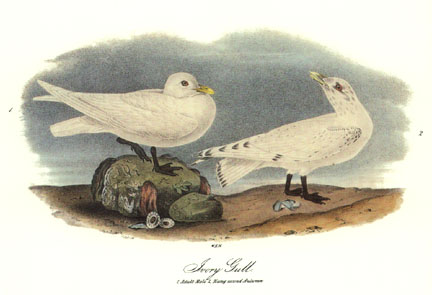

445 IVORY GULL
| Having ascertained that this beautiful species visits the southern
coast of Labrador and Newfoundland every winter, I have thought it
probable that it occasionally extends its rambles as far as our eastern
shores, and therefore determined to include it in my Illustrations. The
figures in the plate were taken from two specimens procured by Captain
JAMES CLARK Ross, one of which was an adult male, the other a young bird
in its second year. Captain SABINE says that the Ivory Gulls are
attracted in considerable numbers by whale blubber, are therefore
usually found in company with the Procellaria glacialis, and are easily
killed, being by no means shy. Dr. RICHARDSON informs us that they were
observed breeding in great numbers on the high perforated cliffs which
form the extremity of Cape Parry, in latitude 70 degrees.
LARUS EBURNEUS, Bonap. Syn., p. 360. IVORY GULL, Larus eburneus, Aud. Orn. Biog., vol. iii. p. 571. Adult, 19, 41. Accidental on the coast of the United States. Common in winter in Labrador and Newfoundland. Breeds in high latitudes. Adult Male. Bill shorter than the head, robust, nearly straight, compressed. Upper mandible with the dorsal line nearly straight at the base, arched and declinate towards the end, the ridge convex, the sides slightly so, the edges sharp, a little inflected, somewhat arched, the tip rather obtuse. Nasal groove rather long and narrow; nostrils in its fore part, lateral, longitudinal, linear, wider anteriorly, pervious. Lower mandible with a prominence at the end of the angle, which is long and narrow, the dorsal line slightly concave and ascending, the sides flattened, the edges sharp and inflected. Head rather large. Neck of moderate length, strong. Body rather full. Feet of moderate length, stout; tibia bare below; tarsus somewhat compressed, covered before with numerous scutella, on the sides and behind with series of small angular scales; the hind toe very small and elevated, the fore toes of moderate length, the fourth much longer than the second, the third longest, the hind one with a single scutellum and three transverse series of scales, the rest scutellate above and connected by reticulate membranes having a concave margin, the lateral toes margined externally with a narrow membrane. Claws stout, rather large, arched, compressed, rather obtuse, that of middle toe with an enlarged inner edge. The plumage in general is close, full, elastic, soft and blended, on the back rather compact. Wings very long, rather broad, acute, the first quill longest, the other primaries rapidly graduated; secondaries broad and rounded, the inner tapering but rounded. Tail of moderate length, even, of twelve rather broad rounded feathers. Bill bright yellow, greenish-dusky at the base. Iris brown, edges of eyelids vermilion. Feet and claws black. The whole of the plumage is pure white. Length to end of tail 19 inches, to end of wings 20 1/2; extent of wings 41; wing from flexure 13 1/2; tail 6 1/4; bill along the back 1 5/12, along the edge of lower mandible 2; tarsus 1 7/12; middle toe 1 2/12, its claw (5 1/2)/12. Weight 20 oz. Young of the second year, killed in September. After the second moult, the bill is pale yellow at the end, dusky at the base for two-thirds of its length; the edges of the eyelids vermilion, the iris brown, the feet black. The plumage is white; the forehead and sides of the head mottled with leaden-grey; most of the wing-coverts have towards the end a spot of greyish-black, and the quills, large coverts, and tail-feathers are similarly marked, the markings on the tail forming a subterminal bar.
|